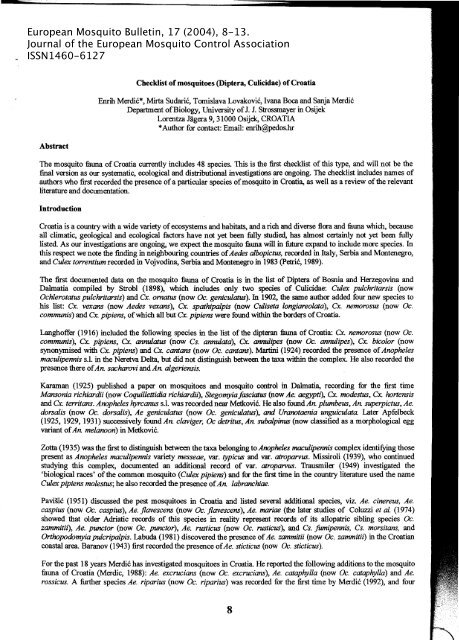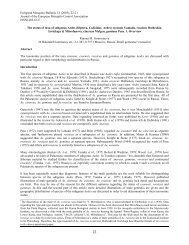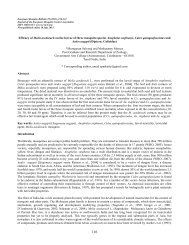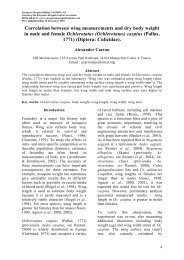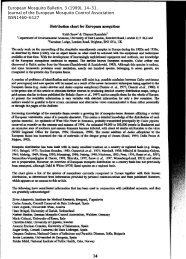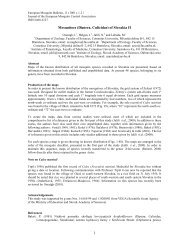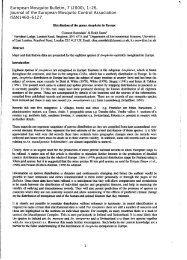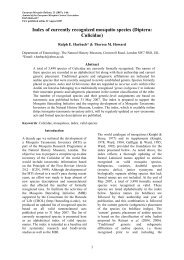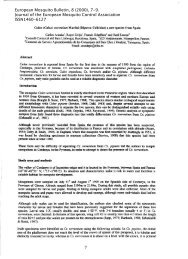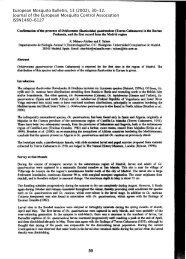Checklist of mosquitoes (Diptera, Culicidae) of Croatia - European ...
Checklist of mosquitoes (Diptera, Culicidae) of Croatia - European ...
Checklist of mosquitoes (Diptera, Culicidae) of Croatia - European ...
You also want an ePaper? Increase the reach of your titles
YUMPU automatically turns print PDFs into web optimized ePapers that Google loves.
<strong>European</strong> Mosquito Bulletin, 17 (2004), 8-13.<br />
Journal <strong>of</strong> the <strong>European</strong> Mosquito Control Association<br />
ISSN1460-6127<br />
Abstract<br />
<strong>Checklist</strong> <strong>of</strong> <strong>mosquitoes</strong> (<strong>Diptera</strong>, <strong>Culicidae</strong>) <strong>of</strong> <strong>Croatia</strong><br />
Enrih Merdic*, Mirta Sudaric, Tomislava Lovakovic, Ivana Boca and Sanja Merdic<br />
Department <strong>of</strong> Biology, University <strong>of</strong> J. J. Strossmayer in Osijek<br />
Lorentza Jagera 9,31000 Osijek, CROATIA<br />
*Author for contact: Email: enrih@pedos.hr<br />
The mosquito fauna <strong>of</strong> <strong>Croatia</strong> currently includes 48 species. This is the first checklist <strong>of</strong> this type, and will not be the<br />
final version as our systematic, ecological and distributional investigations are ongoing. The checklist includes names <strong>of</strong><br />
authors who first recorded the presence <strong>of</strong> a particular species <strong>of</strong> mosquito in <strong>Croatia</strong>, as well as a review <strong>of</strong> the relevant<br />
literature and documentation.<br />
Introduction<br />
<strong>Croatia</strong> is a country with a wide variety <strong>of</strong> ecosystems and habitats, and a rich and diverse flora and fauna which, because<br />
all climatic, geological and ecological factors have not yet been fully studied, has almost certainly not yet been fully<br />
listed. As our investigations are ongoing, we expect the mosquito fauna will in future expand to include more species. In<br />
this respect we note the finding in neighbouring countries <strong>of</strong> Aedes albopictus, recorded in Italy, Serbia and Montenegro,<br />
and Culex torrentium recorded in Vojvodina, Serbia and Montenegro in 1983 (petric, 1989).<br />
The first documented data on the mosquito fauna <strong>of</strong> <strong>Croatia</strong> is in the list <strong>of</strong> <strong>Diptera</strong> <strong>of</strong> Bosnia and Herzegovina and<br />
Dalmatia compiled by Strobl (1898), which includes only two species <strong>of</strong> <strong>Culicidae</strong>: Culex pulchritarsis (now<br />
Dchlerotatus pulchritarsis) and Cx. omatus (now Dc. geniculatus). In 1902, the same author added four new species to<br />
his list: Cx. vexans (now Aedes vexans), Cx. spathipalpis (now Culiseta longiareolata), Cx. nemorosus (now Dc.<br />
communis) and Cx. pipiens, <strong>of</strong> which all but Cx. pipiens were found within the borders <strong>of</strong><strong>Croatia</strong>.<br />
Langh<strong>of</strong>fer (1916) included the following species in the list <strong>of</strong> the dipteran fauna <strong>of</strong><strong>Croatia</strong>: Cx. nemorosus (now Dc.<br />
communis), Cx. pipiens, ex. annulatus (now Cs. annulata), Cx. annulipes (now Dc. annulipes), Cx. bicolor (now<br />
synonymised with Cx. pipiens) and Cx. cantans (now Dc. cantans). Martini (1924) recorded the presence <strong>of</strong> Anopheles<br />
maculipennis s.l. in the Neretva Delta, but did not distinguish between the taxa within the complex. He also recorded the<br />
presence there <strong>of</strong> An. sacharovi and An. algeriensis.<br />
Karaman (1925) published a paper on <strong>mosquitoes</strong> and mosquito control in Dalmatia, recording for the first time<br />
Mansonia richiardii (now Coquillettidia richiardil), Stegomyia fasciatus (now Ae. aegyptl), Cx. modestus, Cx. hortensis<br />
and Cx. territans. Anopheles hyrcanus s.l. was recorded near Metkovic. He also found An. plumbeus, An. superpictus, Ae.<br />
dorsalis (now Dc. dorsalis), Ae geniculatus (now Dc. geniculatus), and Uranotaenia unguiculata. Later Apfelbeck<br />
(1925, 1929, 1931) successively found An. claviger, Dc detritus, An. subalpinus (now classified as a morphological egg<br />
variant <strong>of</strong> An. melanoon) in Metkovic.<br />
Zotta (1935) was the first to distinguish between the taxa belonging to Anopheles maculipennis complex identifying those<br />
present as Anopheles maculipennis variety messeae, var. typicus and var. atroparvus. Missiroli (1939), who continued<br />
studying this complex, documented an additional record <strong>of</strong> var. atroparvus. Trausmiler (1949) investigated the<br />
'biological races' <strong>of</strong> the common mosquito (Culex pipiens) and for the first time in the country literature used the name<br />
Culex pipiens molestus; he also recorded the presence <strong>of</strong> An. labranchiae.<br />
Pavisic (1951) discussed the pest <strong>mosquitoes</strong> in <strong>Croatia</strong> and listed several additional species, viz. Ae. cinereus, Ae.<br />
caspius (now Dc. caspius), Ae. flavescens (now Dc. flavescens), Ae. mariae (the later studies <strong>of</strong> Coluzzi et al. (1974)<br />
showed that older Adriatic records <strong>of</strong> this species in reality represent records <strong>of</strong> its allopatric sibling species Dc.<br />
zammitiz), Ae. punctor (now Dc. punctor), Ae. rusticus (now Dc. rusticus), and Cs. jumipennis, Cs. morsitans, and<br />
Drthopodomyia pulcripalpis. Labuda (1981) discovered the presence <strong>of</strong> Ae. zammitii (now Dc. zammitii) in the <strong>Croatia</strong>n<br />
coastal area. Baranov (1943) first recorded the presence <strong>of</strong> Ae. sticticus (now Dc. sticticus).<br />
For the past 18 years Merdic has investigated <strong>mosquitoes</strong> in <strong>Croatia</strong>. He reported the following additions to the mosquito<br />
fauna <strong>of</strong> <strong>Croatia</strong> (Merdic, 1988): Ae. excrucians (now Dc. excrucians), Ae. cataphylla (now Dc. cataphylla) and Ae.<br />
rossicus. A further species Ae. riparius (now Dc. riparius) was recorded for the first time by Merdic (1992), and four<br />
8
years later Ae. leucomelas (now Qc. leucomelas) and Cx. martinii were discovered (Merdic & Skoda, 1996). Also in<br />
1996 Oc. nigrinus, and Cs. glaphyroptera were recorded in Gorski kotar (Merdic, 1996). Ochlerotatus behningi was<br />
recorded for the first time in <strong>Croatia</strong> in the Maksimir Park in Zagreb (Merdic, 2002).<br />
The presence <strong>of</strong> Cs. subochrea, found in Dalmatia, is reported here for the first time making a total <strong>of</strong> 48=CUITently<br />
recognised species so fur found in <strong>Croatia</strong><br />
The checklist is based on bibliographic data as well as on accumulating knowledge about the existing species. By the mid<br />
20th century 60% <strong>of</strong> the known mosquito fauna <strong>of</strong> <strong>Croatia</strong> had been determined. Like in many other <strong>European</strong> countries<br />
at that time, the interest <strong>of</strong> scientists in <strong>mosquitoes</strong> (especially those <strong>of</strong> the subfamily Anophelinae) was the result <strong>of</strong><br />
widespread malaria. In order to eradicate the disease, it was necessary to study the biology <strong>of</strong> the Anopheles vector<br />
species. After malaria had been eradicated, new species <strong>of</strong> <strong>mosquitoes</strong> were recorded, and previous findings were<br />
confirmed. Mosquitoes were investigated regardless <strong>of</strong> their role as vectors, but the potential possibility <strong>of</strong> disease<br />
transmission was always stressed and more recent papers have focused mainly on applied entomology.<br />
In the literature review references to available publications are marked (*) and other bibliographic data is unmarked.<br />
Because <strong>of</strong> difficulties in finding the oldest literature some <strong>of</strong> which no longer exists, judicious interpretation <strong>of</strong> some<br />
documents had to be exercised.<br />
CHECKLIST (SPECIES RECORDED IN THE CROATIAN LITERATURE)<br />
A total <strong>of</strong> 48 mosquito species have been recorded in Cn>atia, belonging to 8 genera, as follows: Anopheles (11), Aedes<br />
(4), Ochlerotatus (19), Coquillettidia (1), Culex (5), Culiseta (6), Orthopodomyia (1) and Uranotaenia (1).<br />
The list was compiled according to the current list <strong>of</strong> <strong>mosquitoes</strong> in Europe: A revised checklist <strong>of</strong> <strong>European</strong> <strong>mosquitoes</strong><br />
by Snow & Ramsdale (2003), and it is based on the classification and nomenclature <strong>of</strong> mosquito species included in A<br />
catalogue <strong>of</strong> the <strong>mosquitoes</strong> <strong>of</strong> the World (Knight & Stone, 1977) and its supplements (Knight, 1978; Ward, 1884, 1992;<br />
Gaffigan & Ward, 1985).<br />
Family CULICIDAE<br />
Subfamily ANOPHELINAE<br />
Genus Anopheles Meigen, 1818<br />
Subgenus Anopheles Meigen, 1818<br />
1. algeriensis Theobald, 1903<br />
2. atroparvus Van Thiel, 1927<br />
3. claviger Meigen, 1804<br />
4. hyrcanus Pallas, 1771<br />
5. labranchiae Falleroni, 1926<br />
6. maculipennis Meigen, 1818<br />
7. melanoon Hackett, 1934<br />
8. messeae Falleroni, 1926<br />
9. plumbeus Stephens, 1828<br />
10. sacharoviFavre, 1903<br />
Subgenus Cellia Theobald, 1902<br />
11. superpictus Grassi, 1899<br />
(Note 1)<br />
(Note 2.)<br />
(Note 3)<br />
Subfamily<br />
CULICINAE<br />
Genus Aedes Meigen, 1818<br />
SubgenusAedes Meigen, 1818<br />
12. cinereus Meigen, 1818<br />
13. rossicus Dolbeshkin, Gorickaja and Mitr<strong>of</strong>anova, 1930<br />
9
Subgenus AedimOlphus Theoba1d, 1903<br />
14. vexans Meigen, 1830<br />
Subgenus Stegomyia Theoba1d, 1901<br />
15. aegypti Linnaeus, 1762<br />
Genus Ochlerotatus Lynch-Arriblilzaga, 1891<br />
Subgenus Finlaya Theoba1d, 1903<br />
16. geniculatus Olivier, 1791<br />
Subgenus Ochlerotatus Lynch-Arriba1zaga, 1891<br />
17. annulipes Meigen, 1830<br />
18. behningi Martini, 1926<br />
19. cantans Meigen, 1818<br />
20. caspius Pallas, 1771<br />
21. cataphylla Dyar, 1916<br />
22. communis De Geer, 1776<br />
23. detritus Haliday, 1833<br />
24. dorsalis Meigen, 1830<br />
25. excrucians Walker, 1856<br />
26. flavescens Mill1er,1764<br />
27. leucomelas Meigen, 1804<br />
28. nigrinus Eckstein, 1918<br />
29. pulchritarsis Rondani, 1872<br />
30. punctorKirby,1837<br />
31. riparius Dyar and Knab, 1907<br />
32. sticticus Meigen, 1838<br />
33. zammitii Theobald, 1903<br />
Subgenus Rusticoidus Shevchenko & Prudkina, 1973<br />
34. rusticus Rossi, 1790<br />
(Note 4)<br />
(Note 5)<br />
(Note 6)<br />
(includes early record <strong>of</strong> mariae)<br />
Genus Coquillettidia Dyar, 1905<br />
Subgenus Coquillettidia Dyar, 1905<br />
35. richiardii Fica1bi, 1889<br />
Genus Culex Linnaeus, 1758<br />
Subgenus Barraudius Edwards, 1921<br />
36. modestus Fica1bi 1890<br />
Subgenus Culex Linnaeus, 1758<br />
37. pipiens Linnaeus, 1758<br />
Subgenus Maillotia Theoba1d, 1907<br />
38. hortensis Fica1bi, 1889<br />
Subgenus Neoculex Dyar, 1905<br />
39. martinii Medschid, 1930<br />
40. territans Walker, 1856<br />
(Note 7)<br />
Genus Culiseta Felt, 1904<br />
Subgenus Allotheobaldia Bro1emann, 1919<br />
41. longiareolata Macquart, 1838<br />
Subgenus Culicella Felt, 1904 .<br />
42. jumipennis Stephens, 1825<br />
43. morsitans Theobald, 1901<br />
Subgenus Culiseta Felt, 1904<br />
44. annulata Schrank, 1776<br />
45. glaphyroptera Schiner, 1864<br />
46. subochrea Edwards, 1921<br />
(Note 8)<br />
10
Genus Drthopodomyia Tbeobald, 1904<br />
47. pulcripalpis Rondani, 1872<br />
Genus Uranotaenia Lyncb-Arribalzaga, 1891<br />
Subgenus Pseudojicalbia Theobald, 1912<br />
48. unguiculata Edwards, 1913<br />
NOTES<br />
1. Anopheles atroparvus <strong>of</strong> the Anopheles maculipennis complex, i.e. one individual (female) was found in Podravina<br />
in the village <strong>of</strong>Vrbanovac located in the river plainp.ear the Plitvica river-a tributary <strong>of</strong> the Drava (Zotta, 1935).<br />
The same finding (species and number) appeared in 1981-1982 in the village <strong>of</strong> Otok in Podravina (Adamovic &<br />
Paulus, 1983). Missiroli (1939) also recorded the species. Trausmiller (1946) noted that he had not found the species<br />
in any part <strong>of</strong> continental <strong>Croatia</strong>. Since this species is frequently found in V ojvodina, Serbia and Montenegro<br />
(Adamovic, 1979), i.e. in the area <strong>of</strong> salt habitat, the fact that such areas do not exist in <strong>Croatia</strong> could explain the<br />
rarity <strong>of</strong> the species.<br />
2. The taxon Anopheles hyrcanus, Pallas 1771 is reported to comprise an unknown number <strong>of</strong> cryptic species about<br />
which there is no separate information (Ramsdale, 2001). Until this situation is resolved we are obliged to treat this<br />
taxon as a single species.<br />
3. The species Anopheles sacharovi was recorded for the first time in 1924, when Martini conducted research in the<br />
Neretva delta, i.e. in the towns <strong>of</strong>Metkovic, Yid, Vidonje and Opuzen. After the 1st and 2nd World Wars, the lower<br />
Neretva was considered the region <strong>of</strong> endemic malaria. The epidemiological risk from the species Anopheles was<br />
considerable, which asked for more extensive research in the area. The following authors recorded the same species:<br />
Apfelbeck (1925), Karaman (1925) and Zotta (1935), who also found it in the Neretva delta, which was confirmed<br />
by Tartaglia (1949). The species Anopheles sacharovi, Anopheles atroparvus, Anopheles maculipennis, Anopheles<br />
labranchiae, Anopheles messeae and Anopheles subalpinus, belong to the Anopheles maculipennis complex. The<br />
species Anopheles subalpinus is a synonym for the species Anopheles melanoon (Linton et al., 2002).<br />
4. The species Aedes vexans was recorded as early as 1902, when Strobl named it Culex vexans. As the number <strong>of</strong><br />
generations and their abundance depend to a large extent on the water level <strong>of</strong> rivers, it is the reason why this species<br />
is dominant near rivers, many <strong>of</strong> which can be found in Eastern <strong>Croatia</strong>.<br />
5. Ochlerotatus detritus is a species recently found in Istria It was first recorded by Apfelbeck (1929), who was<br />
studying <strong>Culicidae</strong> in Bosnia and Dalmatia This taxon is now known to comprise two sibling species, Oc. coluzzii<br />
and Oc. detritus s,s" with overlapping distributions (Rioux et al., 1990). Ochlerotatus coluzzii has, as yet, been found<br />
only in North Africa and in Western Europe and, until proved otherwise, we continue to regard the <strong>Croatia</strong>n<br />
populations to be <strong>of</strong> Oc. detritus s.S.<br />
6. Larvae <strong>of</strong> Ochlefotatus sticticus develop in floodplains near rivers, or in puddles that remain after snow melt. They<br />
can <strong>of</strong>ten be found with larvae <strong>of</strong> Aedes vexans. Baranov first recorded it in <strong>Croatia</strong> in 1943, whilst investigating<br />
breeding sites <strong>of</strong> flood <strong>mosquitoes</strong> on the banks <strong>of</strong> the river Drava at Osijek.<br />
7. Langh<strong>of</strong>fer first recorded Culex pipiens in 1916. It is the most significant representative <strong>of</strong> the urban mosquito :fauna,<br />
especially in towns and villages on the Adriatic coast, where it is a great problem during the holiday season. Since its<br />
larvae develop in stagnant waters, small breeding sites that are present in urban areas, this is not surprising. As Culex<br />
pipiens is one <strong>of</strong> the main vectors <strong>of</strong> the West Nile virus, it requires further investigation. The name Culex molestus<br />
is still used in some studies as a form within Culex pipiens complex and is useful in stressing physiological and<br />
behavioural differences even though, from a taxonomic point <strong>of</strong> view, it is incorrect (Ward, 1992). For purely<br />
taxonomic reasons we include Culex pipiens only in our checklist.<br />
8. Culiseta subochrea was found in Dalmatia (Merdic), but this has not yet been published.<br />
11
References (*) and bibliography<br />
*Adamovic, Z. (1979) Distribution and abundance <strong>of</strong> anopheline <strong>mosquitoes</strong> (<strong>Diptera</strong>, <strong>Culicidae</strong>) in Vojvodina,<br />
Serbia. Acta entomologica Jugoslavica 15, 75-82.<br />
*Adamovic, Z. (1983) Anophelinae <strong>mosquitoes</strong> (<strong>Diptera</strong>, <strong>Culicidae</strong>) in the Neretva delta, Yugoslavia. Acta<br />
Veterinaria 33, 115-122.<br />
*Adamovic, Z. & Paulus, R (1983) Anophelinae <strong>mosquitoes</strong> (<strong>Diptera</strong>, <strong>Culicidae</strong>) in Podravina, <strong>Croatia</strong>. Acta<br />
Entomologica Jugoslavica 19, 9-17.<br />
Adamovic, Z. & Paulns, R (1985) A new survey <strong>of</strong> Anophelinae <strong>mosquitoes</strong> (<strong>Diptera</strong>, <strong>Culicidae</strong>) in Lika,<br />
Yugoslavia. Glasnik Prirodnjaekog Mureja 40, 169-174.<br />
Adamovic, Z. & Paulus, R (1985) An<strong>of</strong>eline potencijalni vektori arbovirusa u Slavoniji, Posavini, Podunavlju i<br />
Potisju. Zbornik<br />
633-637.<br />
radova XXVI naucnog sastanka mikrobiologa, epidemiologa i infektologa Jugoslavije, pp.<br />
Adamovic, Z. & Paulus, R (1985) Anophelinae species (<strong>Diptera</strong>, <strong>Culicidae</strong>) in the region <strong>of</strong> Zagreb. Acta<br />
Veterinaria 35, 15-162.<br />
Adamovic, Z. & Paulns, R (1987) The indoor resting anophelines (<strong>Diptera</strong>, <strong>Culicidae</strong>) in the Istria Peninsula,<br />
Yugoslavia. Bulletin T. XCII de l'Academie serbe des &iences et des Arts, Classe des &iences<br />
mathematiques et naturelles, Sciences naturelles 27,93-98.<br />
*Apfelbeck, V. (1925) Recherches et observations sur les Arthropodes pathogenes de l'homme et des animaux.<br />
Edition lnspectorat Minist. Sante Pub/. (Sarajevo) 17, 1-48.<br />
*Apfelbeck, V. (1929) Neue Culiciden aus Bosnien und Dalmatien. Konowia 8, 286-295.<br />
Apfelbeck, V. (1930/31) Zur Biologie der in Jugoslavien Beobachteten Dendrolimnokolen Stechmucken (<strong>Culicidae</strong>).<br />
Glasnik jugoslovenskog entomoloskog drustva 5-6, 49-61.<br />
*Baranov, N. (1943) Komarci u Osijeku. Veterinarski arhiv, Zagreb 12, 150-163.<br />
*Coluzzi, M., Sabatini, A., Bullini, L. & Ramsdale, C. (1974). Nuovi dati sulla distribuzzione delle specie del<br />
complesso mariae del genereAedes. Rivista di Parasitologia 35,321-330.<br />
*Gaffigan, T.V. & Ward, RA. (1985) Index to the second supplement <strong>of</strong> A catalog <strong>of</strong> the <strong>mosquitoes</strong> <strong>of</strong> the World<br />
(<strong>Diptera</strong>: <strong>Culicidae</strong>). Mosquito Systematics 17,52-63.<br />
Kaman, M (1928) Rasirenje i biologija vrsti Anopheles maculipennis, Meig. u malarienom podrucju Mure i Drave<br />
(preloski i ludbreski srez). Glasnik Hrvatskog prirodoslovnog drustva, Zagreb 39-40,176-191.<br />
*Karaman, S. (1925) Komarci Dalmacije i njihovo suzbijanje. Glasnik ministarstva narodnog zdravlja, Beograd<br />
*Knight, K.L. (1978) Supplement to A catalog <strong>of</strong> the <strong>mosquitoes</strong> <strong>of</strong> the World (<strong>Diptera</strong>: <strong>Culicidae</strong>). Thomas Say<br />
Foundation, 107 pp.<br />
*Knight, K.L. & Stone, A. (1977) A catalog <strong>of</strong> the <strong>mosquitoes</strong> <strong>of</strong> the World (<strong>Diptera</strong>: <strong>Culicidae</strong>). 200 Edition. Thomas<br />
Say Foundation, 611 pp.<br />
*Labuda, M. (1981) Aedes (Ochlerotatus) zammitii, member <strong>of</strong> Aedes mariae complex (<strong>Diptera</strong>,<strong>Culicidae</strong>) in<br />
Yugoslavia. Bioloski Vestnik 29,23-25.<br />
*Langh<strong>of</strong>fer, A. (1916) Beirtrage zur Dipteren-Fauna Katiens. Glasnik Hrvatskog prirodoslovnog drustva, pp. 29-51.<br />
*Linton, Y-M, Smith, L. & Harbach, RE. (2002) Observations on the taxonomic status <strong>of</strong> Anopheles subalpinus Rackett<br />
& Lewis and An. melanoon Rackett. <strong>European</strong> Mosquito Bulletin 13, 1-7.<br />
*Martini, E. (1924) Uber jugoslavische Anophelen mit besonderer Beriicksichtigungder Frage der misanthropen Rassen.<br />
Archiv.fUr Schiffs- und Tropenhygien; Pathologie undTherapie exotischen Krankheiten 28, 254-265, Hamburg.<br />
Merdic, E. (1986) Prezimljavanje komaraca (<strong>Diptera</strong>, <strong>Culicidae</strong>)u podnnnima na podruCjuOsijeka. University <strong>of</strong>Osijek,<br />
Osijek.<br />
*Merdic, E. (1988) FaunistiCko-ekoloSka istraZivanja komaraca (<strong>Diptera</strong>, <strong>Culicidae</strong>) na sirem podrucju Osijeka.<br />
Prirodoslovno matematiCki fakultet, Zagreb, pp. 1-107.<br />
Merdic, E. (1989) Fluctuation <strong>of</strong> the nwnber <strong>of</strong> <strong>mosquitoes</strong> (<strong>Diptera</strong>, <strong>Culicidae</strong>)in cellars in the winter period in Osijek.<br />
Periodicum biologorum 91,143-144.<br />
Merdic, E. (1990) Anophelinae <strong>mosquitoes</strong> (<strong>Diptera</strong>,<strong>Culicidae</strong>) in Osijek and its surroundings (Yugoslavia). Acta<br />
veterinaria 40,217-224.<br />
*Merdic, E. (1992) Aedes riparius (Dyar & Knab, 1907) newly recorded species <strong>of</strong> <strong>mosquitoes</strong> (Dipt., <strong>Culicidae</strong>) in<br />
<strong>Croatia</strong>. Bioloski vestnik 40, 13-17.<br />
Merdic, E. (1993) Mosquitoes (<strong>Diptera</strong>, <strong>Culicidae</strong>) <strong>of</strong> Special Zoological Reserve "Kopacki rit" (NE <strong>Croatia</strong>). Natura<br />
Croatica 2,47-54.<br />
Merdic, E. (1995) Vertikalna distribucijakomaraca (Dipt. <strong>Culicidae</strong>) na planini Papuk, Hrvatska. Entomologica Croatica<br />
1,25-33.<br />
12
Merdic, E. (1995) Distribution <strong>of</strong> <strong>mosquitoes</strong> in different forest communities. Natura Croatica 4, 143-149.<br />
Merdic, E. (1996) Komarci u Osijeku i bliZoj okolici. Ana/i Zavoda za znanstveni rad u Osijeku 12, 69-82.<br />
*Merdic, E. (2002) Komarci (<strong>Diptera</strong>, <strong>Culicidae</strong>) u parku Maksimir, Zagreb. Hrvatska. Entomologica. Croatica 6, 51-56.<br />
Merdic, E., Boca, 1, Sudaric, M & Lovakovic, T. (2003) Mosquito abundance and activity in Slavonski Brod (Eastern<br />
<strong>Croatia</strong>) with special attention to breeding sites in and out <strong>of</strong> the city. Periodicum biologorum 105,181-187.<br />
*Merdic, E. & Skoda, S. (1996) Two mosquito species from Dalmatia new for <strong>Croatia</strong>n fauna. Natura Croatica 5, 349-<br />
353.<br />
Merdic, E. & Lovakovic, T. (1999) Comparison <strong>of</strong> mosquito fauna in KOpaCki rit in the period 1990-1998. Natura<br />
Croatica 8, 431-438.<br />
Merdic, E. & Lovakovic, T. (2001) Population dynamic <strong>of</strong> Aedes vexans and Ochlerotatus sticticus in flooded areas <strong>of</strong><br />
the River Drava in Osijek. <strong>Croatia</strong>. Joumal <strong>of</strong> the 4merican Mosquito Control Association 17, 275-280.<br />
Merdic, E. & Sudaric, M (2003) Effects <strong>of</strong> prolonged high water level on the mosquito fauna in KopaCki rit Nature Park.<br />
Periodicum biologorum 105, 189-193.<br />
*Missiroli, A (1939) The varietes <strong>of</strong> Anopheles maculipennis and malaria problem in Italy. Verhandludgen VII<br />
Intemationalen Kongresfur Entomologie 1938, Berlin, pp. 1619-1640.<br />
Paulus, R (1982) IstraZivanja rasprostranjenja i brojnosti Anophelinae (<strong>Diptera</strong>, <strong>Culicidae</strong>) u Baranji, s posebnim<br />
osvrtom na vrste vektQre patogenih agenasa. Magistarski rad, Univerzitet u Beogradu, Beograd, pp. 3-33.<br />
Paulus, R (1984) Rasprostranjenje, brojnost i osjet1jivost an<strong>of</strong>elina (Dipt. <strong>Culicidae</strong>), na insekticide u Baranji. Acta<br />
Entomologica Jugoslavica 21, 55-60.<br />
Paulus, R & Adamovic, Z. (1984) An examination <strong>of</strong> the Anophelinae <strong>mosquitoes</strong> (<strong>Diptera</strong>, <strong>Culicidae</strong>) in Slavonia,<br />
Yugoslavia. Glasnik Prirodnjaekog Mureja 39, 71-76.<br />
Paulus, R & Adamovic, Z. (1985) Anophelinae (<strong>Diptera</strong>, <strong>Culicidae</strong>) Hrvatskog primotja, Jugoslavija. Zbomik<br />
radova XXVII naucnog sastanka mikrobiologa, epidemiologa i infrktologa Jugoslavije, Pu1a, pp. 669-672.<br />
Paulus, R & Adamovic, Z. (1987) Anophelinae u nekim krSkim poljima Jugoslavije. Zbomik radova XXVIII<br />
sastanka mikrobiologa, epidemiologa i infrktologaJugoslavije, pp. 182-185.<br />
Pavi~ic, V. (1938) Uber die Okologie der Baumholemuck1enlarven in Jugoslawien. Archiv Hydrobiologie 33, 700-<br />
705.<br />
Pavi~ic, V. (1940) Beitrage zur Fauna Kroates, Die dendrotelmenfauna von Pozega und seiner Umgebung. Archiv<br />
Hydrobiologie 37, 471-476.<br />
Pavi~ic, V. (1941) Prirodni neprijatelji komaraca. Priroda XXXI 5, 17-18.<br />
*PaviSic, V. (1951) Problem komaraca molestanata u SRHrvatskoj. Higijena, Beograd3, 183-208.<br />
*petric, D. (1989) Sezonska i dnevna aktivnost komaraca (<strong>Diptera</strong>, <strong>Culicidae</strong>) u Vojvodini. Univerzitet u Novom Sadu,<br />
Poljoprivredni fakultet, Novi Sad<br />
*Ramsdale, C.D. (200 1) Internal taxonomy <strong>of</strong> the Hyrcanus Group <strong>of</strong> Anopheles (<strong>Diptera</strong>, <strong>Culicidae</strong>), and its bearing<br />
on the incrimination <strong>of</strong> vectors <strong>of</strong> malaria in the west <strong>of</strong> the Palaearctic Region. <strong>European</strong> Mosquito Bulletin<br />
10, 1-8.<br />
*Rioux, J.A, Guilvard, E. & Pasteur, N. (1998) Description d'Aedes (Ochlerotatus) coluzzii n. sp. (<strong>Diptera</strong>, <strong>Culicidae</strong>)<br />
especejumelle A de complexe detritus. Parassitologia 40,353-360.<br />
*Snow, K.R & Ramsdale, C.D. (2003) A revised checklist <strong>of</strong> <strong>European</strong> <strong>mosquitoes</strong>. <strong>European</strong> Mosquito Bulletin 15, I-<br />
S.<br />
*Strobl, G. (1898) Fauna <strong>Diptera</strong> Bosne i Hercegovine i Dalmacije. Glasnik zemaljskog muzeja u BiH, Sarajevo, pp.<br />
10-134.<br />
*Strobl, G. (1902) Dipterianfauna von Bosnien, Hercegovima und Dalmatien-Wissensch. Mitteilungen aus Bosnien<br />
aus der Hercegovina, Wien, pp. 7-160.<br />
Sudaric, M & Merdic, E. (2003) Podrumi, mjesta za prezim1javanje komaraca-brojnost Zbomik radova seminara<br />
DDD i ZUPP. Porec, pp.237-249.<br />
*Tartaglia, P. (1949) On the epidemiology <strong>of</strong> malaria in Dalmatia. Higijena, Beograd 1, 206-220.<br />
*Trausmi11er, O. (1946) Problem malarije u NR Hrvatskoj. Naroclno zdravlje 1, 28-35.<br />
*Trausmi11er, O. (1949) 0 bioloskim rasama obicnog komarca. Higijena, Beograd 1, 272-284.<br />
*Ward, RA (1984). Second supplement to A catalog <strong>of</strong> the <strong>mosquitoes</strong> <strong>of</strong> the World. (<strong>Diptera</strong>: <strong>Culicidae</strong>). Mosquito<br />
Systematics 16, 227-270.<br />
*Ward, RA (1992) Third supplement to A catalog <strong>of</strong> the <strong>mosquitoes</strong> <strong>of</strong> the World (<strong>Diptera</strong>: <strong>Culicidae</strong>). Mosquito<br />
Systematics 24,177-230.<br />
*Zotta, G. (1935) Races d'Anopheles maculipennis en Yugoslavie. Archives Roumaines de Patholologie<br />
Experimentale et de Microbiologie 8, 427-447.<br />
13


